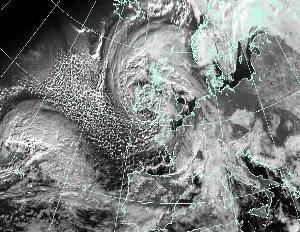Decrypting 1,000 years of past climate history in Europe
Release Date 02 July 2015

Research by University of Reading scientists into climatic patterns from the past 1,000 years has improved our understanding of how the weather in Europe could respond to changes in the future.
In a letter published in Nature, Dr Pablo Ortega from the National Centre for Atmospheric Science (NCAS), based in the University of Reading's Department of Meteorology, and other European colleagues present an unprecedented annually resolved reconstruction of the NAO evolution during the past millennium.
The North Atlantic Oscillation (NAO) describes a seesaw in atmospheric pressure between the regions of the Azores High and the Icelandic Low that controls the flow of winter storms across the Atlantic. It has therefore large impacts on winter climate temperature over Europe.
When the difference in pressure between Azores and Iceland is stronger than normal the NAO enters a positive phase and Atlantic storms are directed towards the British Isles and Northern Europe, carrying precipitation and warmer temperatures, and keep the Mediterranean region on the dry side.
Climate prediction
Recent developments in climate models offer promise to predict the NAO evolution and therefore the climate over Europe from one season to another. However, the lack of long direct observations prevents the assessment of its predictability at longer lead times (years to decades).
This latest reconstruction, carried out at Dr Ortega's previous institution the LSCE/CEA (France), relies on the combination and analysis of climate information from 48 different natural archives or "proxies" distributed around the Atlantic Ocean, including tree rings, speleothems, ice cores and lake sediments.
The final reconstruction indicates that the NAO phase was predominantly positive during the 13th and 14th centuries, but not during the whole medieval period as a previous analysis suggested to explain the unusually warm temperatures in Northern Europe at the time. This former analysis, based only on two natural archives, is also debated by other documentary sources in Europe. To further support their findings, Dr Ortega and colleagues have mimicked and compared both reconstruction approaches in climate simulations with six different state-of-the-art climate models. Their analysis is conclusive; all the models support the new reconstruction as a more reliable estimation of past NAO variability.
"This validation with models is a novel encouraging approach for the paleoclimatology community", Dr Ortega explains.
"Up to now, natural archives have been used to assess the ability of climate models to reproduce past climate variability. Our study has shown the added value of using models to test the reliability of paleoclimate reconstructions."
Another important result, with implications for climate prediction over Europe, is the identification of a systematic NAO response to volcanic eruptions. In the reconstruction, positive NAO phases emerge two years after strong volcanic eruptions, consistent with satellite observations for the Mt Pinatubo eruption in the Philippines.
